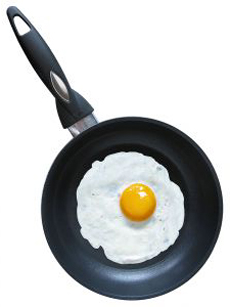
 Olive oil? Butter? Canola oil? What fat should you use to fry your eggs? Photo by Davide Guglielmo | SXC.
January 2010
|
 |
Cooking Oil Smoke Points
You May Love That Oil, But Can You Cook With It?
CAPSULE REPORT: All cooking fats are not created equal. Some can be used at high heats, some can’t. Some are healthier than others. Here, we explain the smoke point of fats, along with a chart of cooking fats to help you determine the best ones for your needs. However, a high smoke point isn’t the only solution you should seek. Page 3 discusses healthy fats versus less healthy fats so you can find a cooking fat that’s also good for you and your family. This is Page 1 of a four-page article. Click on the black links below to visit other pages.
Introduction To Smoke Point
When cooking with fat, you need to know its smoke point, the temperature at which the fat (including butter, lard, oil and shortening) begins to break down. Fats break down into glycerol and free fatty acids; the glycerol then breaks down into acrolein, which is a component of the smoke in the “smoke point.” At this point, both the flavor and the nutritional value of the fat begin to degrade. The higher the heat, the higher smoke point your fat must be.
That’s why grapeseed oil (485°F), soybean oil (490°F) and safflower oil (510°F) are so popular for deep fat frying. Avocado oil has the highest smoke point (520°F), but is more expensive to produce. For a quick stir-fry or a medium-heat sauté, you can use a lower smoke point fat. Tree nut oils have relatively high smoke points, but are expensive and heat destroys their delicate flavor; they’re better used to dress cold and cooked dishes.
Note that the smoke points from different sources can vary slightly, depending on the source of the data and the testing methodology. Our data comes from a mixture of manufacturers, trade associations and government data.
What Fat Do You Need?
Match fats to the cooking instructions:
- Sauté or Fry: 325°F to 375°F, medium smoke point or higher
- Stir-Fry: 420°F, high smoke point or higher
- Deep-Fry: 450°F, high smoke point or higher
The best oils for deep-frying and high temperatures are refined safflower and sunflower oils, peanut, safflower and soy oils. Refined almond, avocado and cottonseed oil are also great if you can find and afford them, and canola oil is usually not a problem either.
Continue To Page 2: Smoke Point Chart
Go To The Article Index Above
Lifestyle Direct, Inc. All rights reserved. Images are the copyright of their individual owners.

|
| |




 Olive oil? Butter? Canola oil? What fat should you use to fry your eggs? Photo by Davide Guglielmo | SXC.
Olive oil? Butter? Canola oil? What fat should you use to fry your eggs? Photo by Davide Guglielmo | SXC.